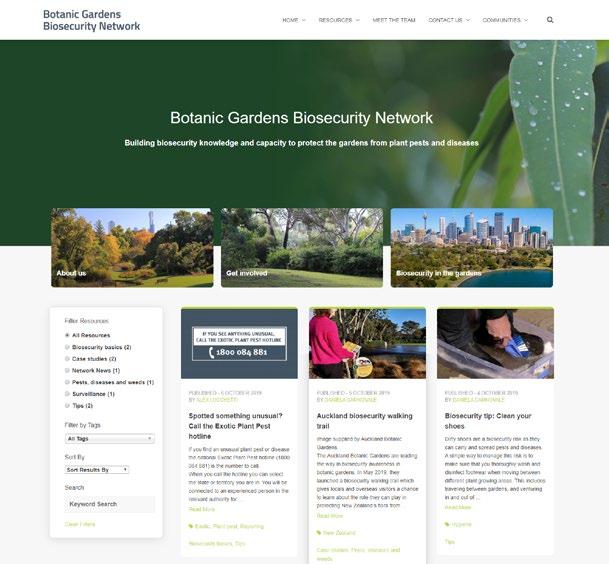
20 minute read
Australian botanic gardens join fight against plant pests
Greg Fraser, Executive Director and CEO, Plant Health Australia Daniela Carnovale, Project Officer, Plant Health Australia David Gale, Project Officer, Plant Health Australia Alex Lucchetti, Communication Officer, Plant Health Australia
The declaration of 2020 as the International Year of Plant Health by the United Nations General Assembly recognises the importance of protecting the health of plants from pests and diseases which threaten our food security, economy, environment and way of life.
As the year approaches, we are also presented with an opportunity to reflect on ways we can engage governments, industries and the wider community in protecting plant health. This includes the staff, friends, guides and other communities associated with botanic gardens.
A risk and an opportunity
Introduced plant pests and pathogens present a significant risk to plant health in home gardens and botanic gardens alike. These organisms can have ecological and economic impacts on their new environs and the native species which inhabit them, with the potential to cause irreversible and large-scale damage. The growing global trade in plants and plant material are increasing the potential spread and subsequent establishment of these organisms.
Botanic gardens represent both a risk and an opportunity in the fight against the international spread of plant pests and diseases.
Visited by millions of people each year, botanic gardens are often one of the first places that overseas travellers visit. As a result, botanic gardens are at risk from new pests entering on the clothing or footwear of visitors. Due to this risk, botanic gardens provide an opportunity to detect new pests early.
The living plant collections found within botanic gardens and arboretums are a unique resource that can provide vital information regarding plant health. These botanic gardens and arboreta hold a range of native flora, exotic species from all over the world and relatives of commercial crop species. This provides an opportunity to help overcome one of the key challenges when it comes to identifying and assessing threats to plant health – that most serious invasive pests do not cause problems in their native habits.
Non-native species in botanic garden collections can be observed to see how they are impacted by pests that may not be present in the plant’s native country or area. Plants used in this way are known as sentinels.
The International Plant Sentinel Network (IPSN) actively uses this approach by linking botanic gardens and arboreta, plant protection organisations, and plant health scientists around the world to provide an early warning system of new and emerging pest and disease risks.
Botanic gardens and arboreta including Royal Botanic Gardens Victoria, Royal Botanic Gardens Sydney, the Australian National Botanic Garden, the Royal Tasmanian Botanical Garden and the National Arboretum Canberra have signed up as members of the IPSN to:
• develop methodologies for monitoring damaging plant pests and pathogens in gardens
• provide training materials to increase capacity
• facilitate access to diagnostic support
• build connections between people associated with IPSN member botanic gardens and arboreta.
Botanic Gardens Biosecurity Network is being piloted with friends, guides and visitor experience officers at three gardens.
The Australian approach
At a national level, Australia’s botanic gardens and arboreta have been recognised for the role they can play in our national plant biosecurity system. The collaborative effort between federal and state governments, industry and the broader community helps keep plant pests and diseases from entering or moving around Australia to maintain healthy and productive plants.
Staff and volunteers working with plants in the collections of botanic gardens on a regular basis can quickly and accurately recognise, monitor and record changes in plant health. These staff and volunteers are typically knowledgeable and passionate people, who with training and awareness of current threats, can become additional ‘eyes and ears’ for first detection of plant pests and diseases.
With coordination and support from Plant Health Australia, the knowledge, experience and passion of both botanic garden staff, and the friends, guides and other volunteers are being harnessed in two new biosecurity networks.
One network brings together staff to undertake coordinated surveillance, while the other seeks to draw on friends and guides who support the gardens. The data generated by each network will be used to help safeguard plant health on a local and regional scale, and globally through the IPSN. The surveillance data will also help prove Australia’s freedom from certain plant pests.
Coordinated surveillance by botanic garden staff
The Botanic Gardens Surveillance Network has engaged staff of botanic gardens in Western Australia, South Australia, Victoria, Tasmania, New South Wales and the Australian Capital Territory. Once a month over spring and summer staff at participating gardens will look for five target pests on 5–25 potential host plants. They will report whether the pest was not found (absence data) or any suspected discoveries of the pests.
The five target pests are:
• Rose rosette virus
• Myrtle Rust Austropuccinia psidii
• Brown-marmorated stink bug Halyomorpha halys
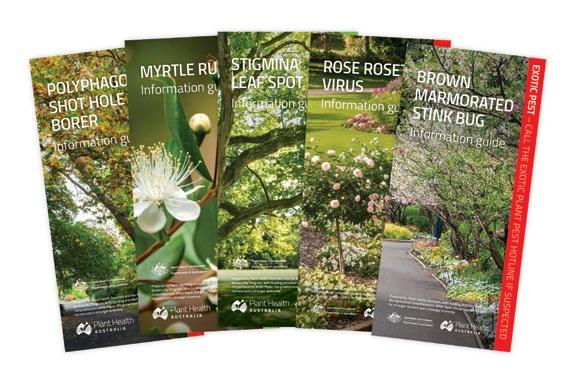
• Polyphagous Shot Hole Borer Euwallacea whitfordiodendrus
• Stigmina leaf spot Stigmina platani
These pests were chosen based on whether they have observable symptoms, if they fitted in with existing national and botanic garden surveillance programs and activities, and are considered a priority. Absence data plays an important role in showing that Australia is free of certain pests which can help with trade negotiations for our agricultural products.
Engaging botanic garden communities
As many gardens are reliant on their friends, guides and other volunteers for hands-on help with horticultural care, research, outreach, advocacy and fundraising, it is anticipated that these groups are critical for undertaking surveillance for new plant pests.
The second network is called the Botanic Gardens Biosecurity Network and is being piloted with friends, guides and visitor experience officers of the Royal Botanic Gardens Sydney, Royal Botanic Gardens Victoria, Melbourne and the Australian National Botanic Garden.
To assist friends and volunteers in general surveillance, a Community of Practice is being established on the extensionAUS™ platform to connect them with biosecurity and surveillance experts. By working together, the involved friends, guides and other volunteers will learn how to look out for exotic plant pests in their botanic and home gardens and how to keep gardens safe from new pests.
A website, hosted by extensionAUS™, has been developed for the Botanic Gardens Biosecurity
Network to provide practical information and advice to staff of botanic gardens, community
interest groups and members of the public to develop awareness, knowledge and skills
to contribute to general biosecurity surveillance activities. The site is now live at extensionaus.com.au/botanicgardensbiosecurity
More information
This is the story of plant life on Earth, uniquely retold through a remarkable record of spectacular fossils. Palaeobotanist Paul Kenrick explains the importance of each fossil and how it marks a crucial inflection point in plant evolution. Each discovery is illustrated with special photography featuring many original specimens from the Natural History Museum, London.
For more information about either of these networks please email botanicgardens@phau.com.au
For more information about the International Year of Plant Health visit planthealthyear.org.au or fao.org/plant-health-2020/en/
For more information about the IPSN visit plantsentinel.org
A History of Plants in 50 Fossils PLC V002 CSIRO cs6.indd 1
It starts with science.

A HISTORY OF plants IN 50 FOSSILS
PAUL KENRICK


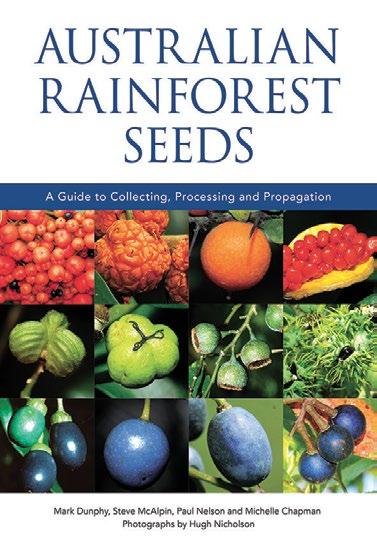

19/11/2019 15:40
Visit the CSIRO Publishing website for more quality science books, journals and magazines
Care for the Rare – BGANZ congress workshop*
John Arnott, Manager Horticulture, Royal Botanic Gardens Victoria Cranbourne Gardens
The Wellington congress was the perfect opportunity to explore the range of approaches to plant conservation currently undertaken by botanic gardens. While the workshop was named after Royal Botanic Gardens Victoria’s (RBGV) Care for the Rare project, with its focus on conservation horticulture and display, the workshop could quite legitimately have been retitled ‘Towards metacollections: exploring approaches for conservation collaborations’. Presenting with co-facilitators Bec Stanley, Chris Russell and Paul Tracey, we delivered a series of conservation case studies that demonstrated the diversity of ‘tools in the integrated plant conservation toolkit’ and showed that botanic gardens are increasingly important contributors to collaborative conservation work. On this foundation, the entire group then explored how we might achieve even more effective plant conservation outcomes by examining appetite, obstacles and opportunities – a group discussion well worth sharing with you all.
Case studies: a diversity of approaches
Paul Tracey, Parks & Open Space Manager Wollongong, provided an overview of his 2018 Masters study which explored ‘Australian Local Government’s contribution to plant conservation’.
Two key themes were associated with the study: ‘What are gardens currently doing in plant conservation?’ and ‘What are the benefits to regional botanic gardens arising from establishing conservation partnerships?’
Paul detailed key findings of the study, as outlined below:
• Local government gardens do have a meaningful role to play in plant conservation
• Numerous local government gardens are playing an active role, many are not, particularly in Victoria
• Perceived constraints to participation are a lack of accreditation (recognition) and research capacity
• There are numerous measurable benefits to collaborations which are being realised by active collaborators.
Paul also reflected on individual partner strengths: state government delivering science and research; local government with strong horticultural management, knowledge of natural areas, access to local land manager experts and access to local promotion and media.
BGCI Integrated Plant Conservation
Bec Stanley, Curator Auckland Botanic Gardens, showed workshop participants a Botanic Gardens Conservation International (BGCI) Integrated Plant Conservation table which explored the various skillsets, roles and functions associated with integrated plant conservation. Bec noted the red circles as the potential activity areas for botanic gardens (observing that some gardens do manage tracts of land and do practice in situ conservation but they are generally the exception to the rule).

Bec also provided details of an Memorandum of Understanding (MOU) that BGANZ New Zealand has signed with the New Zealand Department of Conservation (DOC), noting that collectively New Zealand gardens are very committed to contributing to Target 8 of the Global Strategy for Plant Conservation. Bec reflected on the fact that traditionally botanic gardens in New Zealand had not been regarded as part of the conservation community, and conservation was seen to be the realm only of DOC, despite DOC having no horticultural staff, display gardens or, until recently, botanical staff.
The MOU has served as a mechanism to legitimise the role of New Zealand botanic gardens in conservation, thereby building capacity to offer specialist services and expertise. It is a framework for collaboration around management of threatened plants with DOC, Iwi and community and private sector players. Importantly the MOU provides opportunities to collectively set priorities for ex situ and integrated plant conservation actions based on a national strategy for plant recovery.

Representatives of BGANZ New Zealand signing the MOU with members of New Zealand’s Department of Conservation, (l to r) BGANZ (NZ) Convenor and Auckland Botanic Gardens Curator Bec Stanley, DOC Director General Lou Sanson, Auckland Botanic Gardens Manager Jack Hobbs and Hon Maggie Barry.
RBGV Care for the Rare project
RBGV’s Care for the Rare project was presented as much about building capacity for regional botanic gardens in Victoria as a conservation program. The aim of the project is to establish a multi-site conservation collection of Victorian Rare or Threatened plant species (VROTs).
As indicated in Paul Tracey’s study, very few regional botanic gardens in Victoria have been active in plant conservation activities. The case study explored the background to this with perceived impediments to participation including challenges in sourcing rare and threatened plant material and a general lack of information about their cultural requirements and perceptions that indigenous plants might be incongruous or out of character in heritage landscapes (the majority of regional gardens in the state being established in the late 1800s and firmly based on European influences and landscape character).
Over many years BGANZ Victoria has been actively exploring how to encourage and support regional gardens in participating in conservation activities. More recently, RBGV successfully gained funding support from the Helen Macpherson Smith Trust to activate the Care for the Rare project and to work collaboratively with regional gardens to establish conservation collections.
The broad aims of the project were outlined as supporting regional botanic gardens in developing collections of locally significant rare and threatened plant species through:
• Providing technical and curatorial support through co-developing Conservation Collection Plans for each participating garden
• Working closely with key gardens staff to develop a sustainable approach to the development of conservation collections
• Identifying program scope and complexity commensurate with individual gardens capacity
• Sourcing, propagating and supplying a range of R&T Victoria taxa for distribution to participating gardens, and
• Maximising opportunities for interpretation, and promotion of the project, particularly at regional and local levels.
BGANZ Victoria opened expressions of interest to Victorian gardens to participate in the project and were ‘overwhelmed’ with 24 applications. Six gardens were selected to pilot the program: Care for the Rare site inspection at Colac Botanic Garden (CBG), (l to r) Ed Richies (CBG), John Arnott, Laurence Towers (CBG) and Tex Moon. Photo: Chris Russell

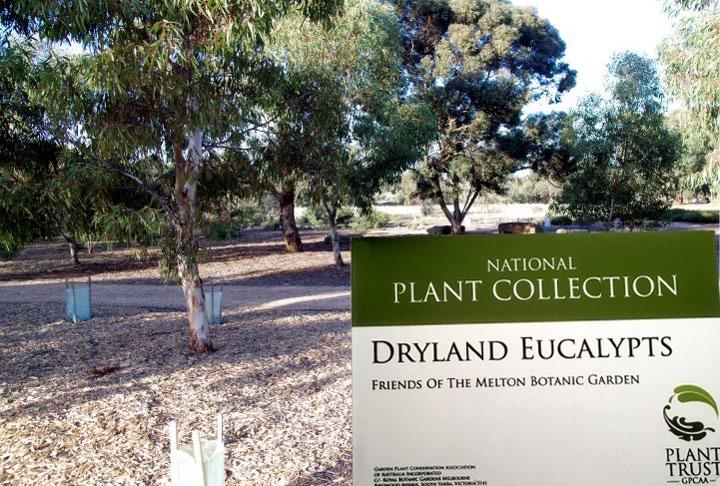
Melton Botanic Garden National collection of dryland Eucalypts. Photo: John Bentley
• Ballarat Botanical Garden
• Colac Botanic Gardens
• Dandenong Ranges Botanic Garden
• Sale Botanic Garden
• Shepparton Botanic Gardens
• Wilson Botanic Park Berwick.
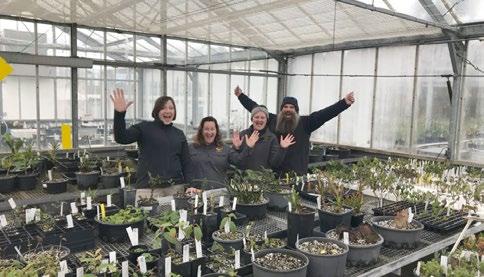
The Cranbourne Gardens Nursery team propagating Care for the Rare collections, from (l to r) Maja Zwek, Mandy Thomson, Sarah Foray, and David Perkins.
After several site visits and planning sessions, Conservation Collection Plans have been written for each participating garden which outline the broad objectives and scope for each collection, with associated plant lists. Plant propagation and production has commenced at the RBGV Cranbourne Gardens Nursery and planting will begin in 2020.
South East Bioregion Partnership
South East Bioregion Group Partners Paul Tracey Wollongong Botanic Garden, Paul Ardler Booderee National Park, Kylie McClelland OEH, and John Siemon Mt Annan Botanic Gardens. Paul Tracey explained that the South East Bioregion Group started out as an informal botanic gardens’ collaboration with a strong geographic and regional focus (Southern Sydney and South East Bioregion of New South Wales). It has since gone from strength to strength, to partner with a range of other conservation agencies and land managers. The partnership comprises representatives from the Australian National Botanic Gardens, Wollongong Botanic Gardens, Eurobodalla Regional Botanic Gardens, Booderee Botanic Gardens, the Australian Botanic Garden Mount Annan, Illawarra Grevillea Park and the New South Wales Office of Environment and Heritage (OEH) Ecosystems and Threatened Species team.

There are similarities to the New Zealand model, with botanic gardens working with the OEH and local councils sharing resources to actively manage threatened species.
Although this group targets a wide range of rare and significant flora from the region, it has some specific priorities. One recent example is the work under way for the endangered Bomaderry Zieria, Zieria baeuerlenii. This species has been cultivated over many years as an ex situ collection at Booderee Botanic Gardens, the Australian National Botanic Gardens and, more recently, at Wollongong Botanic Gardens. The group is planning to use some of the ex situ plants for wild population enhancement and as cultivated plants for educational purposes. Another example of collaboration within the partnership is work being undertaken for the recently discovered Banksia vincentia, likely Australia’s rarest Banksia.
The model is based on genuine working relationships with a range of conservation agencies. Roles and responsibilities are clear and based on skill sets and capacity. From a botanic garden perspective, the partnership facilitates the sharing of resources and more importantly of not duplicating effort.
Tropical Mountain Plant Science and ex situ Conservation Project (TroMPS)
Chris Russell, Executive Director Cranbourne Gardens, described a new conservation consortium, comprising universities, herbaria and botanic gardens that is aiming to collect and establish ex situ holdings of 70 threatened plant species endemic to the high mountain peaks of Far North Queensland. The main concern for these plants relates to climate modelling and the prediction for the Queensland peaks to become hotter with less reliable rainfall across the year. Given that these target species quite literally occur nowhere else on Earth, establishing populations in botanic gardens in ex situ holdings could act as backstop or emergency populations, if indeed wild populations disappear through changing conditions.

TroMPS is a multi-disciplinary group with the Australian Tropical Herbarium (ATH) based at James Cook University, the lead agency. Other agencies include the Wet Tropics Management Authority, Western Yalanji (and other Indigenous groups), Australian National Botanic Garden, Royal Botanic Gardens Victoria, Australian Seed Bank (Sydney), Royal Botanic Garden and Domain Trust (Sydney), Australian Rhododendron Society (Victoria), Cairns Botanic Garden, Brisbane Botanic Gardens and Earthwatch. Participants at the launch of the plant collecting phase of the project – back, (l to r): Arun Singh Ramesh (JCU), Lydia Guja (ANBG), Warren Worboys (RBGV), Stuart Worboys (ATH), Donna Davis (Artist), Karen Sommerville (RBGS), Gemma Cotterell (RBGV); front, (l to r): Prof. Darren Crayn (JCU), Peter Bredell (ANBG), Therese Turner (RBGV) As with previous examples, the various players in the consortium will bring different skills and focus to the group. The ATH will be responsible for field collection, documentation and identifying target species for inclusion in the program, the ANGB, RBGV and the National Seedbank at Sydney are the main propagators, holders and distributors of material. It is envisaged that the collection would be a meta-collection held across numerous botanic gardens in eastern and southern Australia. It is worth noting that the best climate matched gardens are likely to be the cluster of cool climate gardens in South East Australia, some thousands of kilometres from the source. It was pointed out that this approach is akin to captive breeding holdings across the zoo network, which poses some interesting questions and potential further discussion.
Plant Trust Australia (and National Collections)
All previous case studies focused on wild plants with conservation significance, broadly referred to as threatened species. Botanic gardens also play an important role in the conservation of ornamental collections. The last case study explored this through the activities of Plant Trust (the current name of the Ornamental Plant Conservation Association of Australia), that was formed in 1986.
In the mid-1980s there was a growing concern about the trend away from diversity of nursery stock available for both private and public gardens. It was apparent that horticulture was losing potentially important plant cultivars and varieties. Plant Trust was modelled on the United Kingdom National Council for the Conservation of Plants and Gardens which currently has over 650 registered collections and a membership of thousands.
In Australia there are around 60 national collections which are mostly held by private collectors, although there are a small number in botanic gardens and public gardens such as Tuberous Begonias – Ballarat Botanical Gardens, Dryland Eucalyptus – Melton Botanic Gardens, Telopea – Karwarra Gardens, Kalorama Victoria.
For regional botanic gardens with modest resources, access to plant material to establish new collections is often cited as a major barrier. Plant Trust are interested in exploring the duplication of existing private collections in botanic gardens and are encouraging botanic gardens to register existing collections as national collections. https://planttrust.org.au
Group discussion and workshop
There were 30 participants at the workshop who broke into groups to discuss four workshop prompts:
• Is there an appetite to explore further collaborative conservation projects within BGANZ regional group/s?
• What model/s would best fit the needs of the groups?
• What are some of the perceived obstacles for multi-site conservation programs?
• Is there a role for BGANZ Council in supporting collaborative conservation programs?
Some of the reflections emerging from the group discussions are outlined below. Overwhelmingly, a strong desire to continue to explore conservation collaborations and multi-agency programs was identified and indeed, it was pleasing to note that there is already significant work happening in this space.
A diversity of approaches
It was noted that the numerous approaches (or models) discussed in the case studies had significant differences in their methodologies and potential conservation outcomes; that is, programs with strong display and interpretation focus versus programs with a focus on translocation and plant reintroductions; diverse multi-agency programs versus programs with a single lead; pragmatic plant selection versus prioritised selection based on conservation need; strong focus on local conservation initiatives versus ‘assisted migration’ of entire collections to suitable garden conditions well away from source; programs with strong science and ecological reference points versus horticultural approaches; jump in and do something versus formulating agreements and policies.
What resonated with the groups was the strength in diversity, which was apparent with the various approaches tabled. It was agreed that botanic gardens are players in the broader conservation network and our skillset is both specialist and required. Specifically, our capacity to propagate and grow material for a range of purposes including display, distribution, duplication, translocation, and research.
Programs where the scope and complexity of the project commensurate with the garden’s capacity resonated particularly with regional gardens. It was agreed that it is completely legitimate for some gardens just to display, while others might go to the level of return to the wild/seed orchards. There was discussion around a two- (or three-) tiered approach or a staged approach, where one leads to the other.
Plant records
There was a strong desire to find out what threatened species are currently in holdings across Australia and New Zealand (with provenance data). Noting this was consistent with the aims of the Botanic Gardens Collections and Records Management Group (BCARM) project and BGCI’s desire to gain current and accurate information on Australasian collections.
Metacollections
The development of co-ordinated metacollections (rather than isolated holdings) was clearly supported as a logical direction for botanic gardens to take into the future. The BGCI definition of a metacollection is:
The combined holdings of a group of collections. For gardens, metacollections are envisioned as common resources held by separate institutions but stewarded collaboratively for research and conservation purposes. Networking multiple collections into a metacollection increases potential coverage within a group, allows better access to greater diversity, dilutes risk of loss, and can reduce maintenance costs.
BGANZ’s role
It was broadly agreed that there is a role for BGANZ in facilitating and supporting the development of metacollections. This could potentially be facilitated through establishing a BCARM conservation working group. There was some talk of the development of a conservation toolkit or an update to the existing BGANZ collections management toolkit, which will be explored. National collections and investigating opportunities with Plant Trust (in Australia) on registering botanic gardens collections was again supported as something for BGANZ to explore with the Plant Trust committee.
Opportunities for regional groups to support a more coordinated approach were discussed with an agreed action for workshop facilitators to approach each BGANZ regional group convenor and encourage regional group discussions around the metacollection concept. Arising from the workshop, New Zealand has already identified several actions and next steps.
Thanks to all the participants for attending what was a lively and hopefully fruitful workshop!
* Presented at the 9th BGANZ Congress










